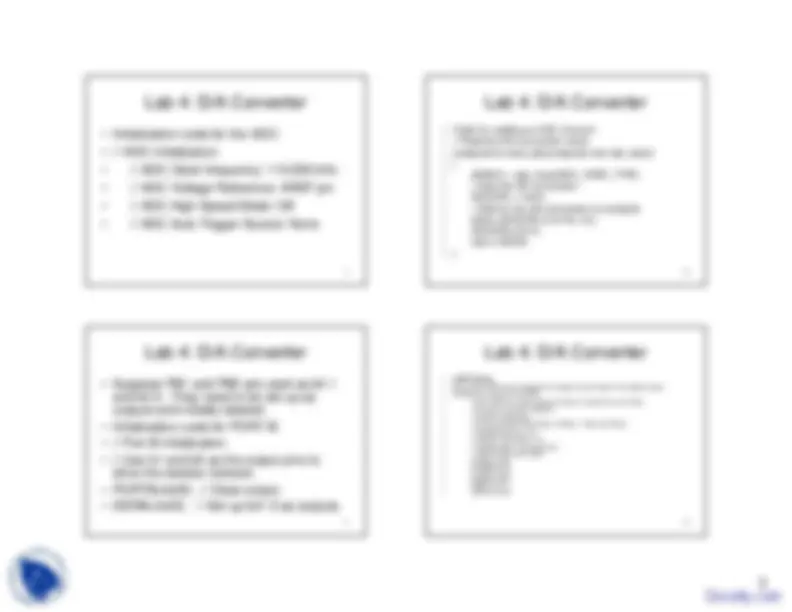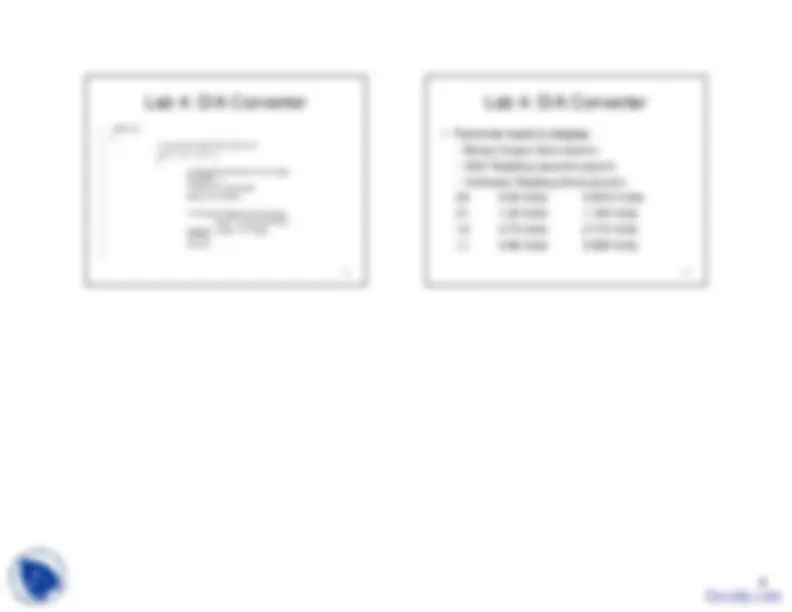




Study with the several resources on Docsity

Earn points by helping other students or get them with a premium plan


Prepare for your exams
Study with the several resources on Docsity

Earn points to download
Earn points by helping other students or get them with a premium plan
Community
Ask the community for help and clear up your study doubts
Discover the best universities in your country according to Docsity users
Free resources
Download our free guides on studying techniques, anxiety management strategies, and thesis advice from Docsity tutors
These are the Lecture Slides of Embedded System Design which includes Hardware Design, Elevator Controller, Simple Elevator Controller, Try Capturing, Unit Control, Request Resolver, Sequential Program Model, Partial English Description, System Interface etc. Key important points are: Converter, Equations, Outputs, Analog Value, Large Currents, Appropriate Values, Construct Circuit, Connect Circuit, Verify and Document, Outine Delay
Typology: Slides
1 / 4

This page cannot be seen from the preview
Don't miss anything!



1
2
1000
This is a simple resistive network for a D/A converterPort 1, Port 0 are digital inputs ==> 00 (minimum), 01,10, 11 (maximum)You need to design the resistive network to generateproper outputs.For ECE5430 students, a four-bit D/A with an Op-amp isrecommended.
1000 ohms
3
ATMEGA
PB1 PB0 ADC0(PA0)
VTG
RXDTXD
To Computer Serial Port
AREF
STK
357 833 1000
R
R3^ R
VA
STK500 reads the analog value from VA using ADC channel 0
4
Equations for D/A Outputs:
-^
0.0 VS = (R1 || R2 || R3 ) * (0 Volts)
0.3 VS = (R1 || R3 ) * (5 volts) / ((R1 || R3 ) +R2 )
0.7 VS = (R1 || R2 ) * (5 volts) / ((R1 || R2 ) +R3 )
1.0 VS = R1 * (5 volts) / ((R2 || R3 ) + R1 )
Given: VS = 4 Volts, R1 = 1000
-^
Find R2 and R3 by solving 2 equations with 2 variablesusing the equations for B’01 and B’11.
Here we choose R1 = 1000 ohms.You can choose any proper value you want for R1.If R1 is too small, it may require large currents resulting inoverheat problem.
5
Theoretical vs Actual DAC
5.04.5 4.03.53.0 2.52.01.5 1.00.5 0.
0
1
2
3
4
Binary Output
DAC Output (V)
Theoretical DACActual DAC
6
5.000V
5.000V
0V
0V
R2 833
1.200V 0V
R5 833
R11k 2.800V
R3 357
V 5Vdc
R9 357
0V^0
0
V 5Vdc
0
R12 357
0
0V R71k
R6 357 R11 833
0 0
R8 833
R41k 4.000V 0
0
V 5Vdc
R101k
7
In-Lab Tasks
-^
Construct Circuit 4-1 with appropriate values ofresistance. Do NOT connect Circuit 4-1 to the AVR mcu.
-^
Given your computed values of R2 and R3, verify thevoltage of VA for the four possible port values.
-^
Connect Circuit to the AVR mcu.
-^
Write software for the AVR mcu that sets analogvoltages at VA. Have the software loop through thevoltages from 0.0VS, 0.30VS, xVS, , .. ,1.0VS and stepback down to 0.0VS. Include a delay between eachvalue. Use the C-routine delay_ms() in <delay.h> togenerate the delay.
-^
Verify and document the resulting voltages of VA.
8
Initialize peripherals in ATMEGA
μP:
•Port x : Output to LED’s • Port x : DAC output on pins 0 & 1 • Port D : UART on pins 0 & 1 • UART : 9600 baud, 8-N-
Display opening marqueeStart counter at 0
Start
Port x = counter (to DAC)Port x = ~ counter (to LED’s)Increment counter so it runs: 1, 2, 3, 4, 1, 2 …Delay 2.5 seconds for voltage measurement
Sample of Software flowchart
13
-^
while (1)
-^
{
-^
// Loop from b00, b01, b10, b11.
-^
for( i = 0; i < 4; i++ )
-^
{
-^
// Change to the next D to A step.
-^
PORTB = i;
-^
// Delay for 2 seconds
-^
delay_ms( 2000 );
// Print the voltage to the screen.
-^
value = read_adc( 0x0 );
-^
voltage = value * 5 / 1023;
-^
??????
-^
??????
14
0.00 Volts
0.0012 Volts
01
1.20 Volts
1.194 Volts
10
2.75 Volts
2.710 Volts
11
3.96 Volts
3.906 Volts